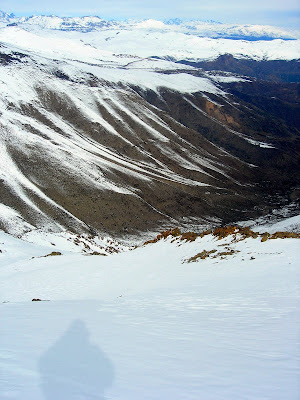I came across this video while searching for information about Sam Amidon, the performer of this traditional American folk song.
Known variously as "Saro," "Pretty Saro," "Pretty Sarry," or "Pretty Sarah," the song is said to be a relative of "At the Foot of Yonder Mountain," as well as the Irish tune "The Streams of Bunclody," neither of which I know anything about.
While traveling through the Appalachian states in 1916-1918 the British ballad scholar Cecil Sharp collected versions of this song, labeled it #76, and published it in his famous collection English Folk Songs from the Southern Appalachians. If it is connected to the Irish song "The Streams of Bunclody" then, apparently, the song dates back to at least 1749, though the version that evolved into "Pretty Saro" was probably created sometime between 1749-1849--the date that is mentioned in the song. Whether the heartbroken immigrant who wrote this tune sent "The Streams of Bunclody" or "Pretty Saro" back to Ireland is unknown.
Here are two transcribed versions of the song. The first was collected in Asheville, North Carolina, the second in the Blue Ridge Mountains of Virginia. Both were collected in 1930.
Pretty Saro
I came to this country in seventeen-forty-nine,
I saw many a true love, but I never saw mine.
I looked all around me and found I was alone.
And me a poor stranger, and a long way from home.
Down in some lonesome valley, down in some lonesome place,
Where the wild birds do whistle their notes to increase,
I think of pretty Saro whose waist is so neat,
And I know of no better pastime than to be with my sweet.
I wish I were a poet and could write a fine hand,
I would send my love a letter that she could understand.
And I'd send it by a messenger where the waters do flow
And think of pretty Saro wherever I go.
Pretty Sarah
Down in some low valley in some lonesome place,
Where the small birds to whistle their notes do increase.
I think on pretty Sarah and her ways air so compleat,
I could wish no better pastime than to be with my sweet.
I came to this country eighteen-sixty-nine,
I saw many lovers but I never saw mine.
I looked all around me, I found I was alone,
And I a poor soldier and a long ways from home.
I wish I was a larks man and had wings and could fly
Down in my love's window this night I would lie.
All day and all night I would set down and cry,
And in my love's lily white arms this night I would lie.
I wish I was a penceman (pen-man, i.e writer) and could write a fine hand,
I would write my love a letter that she might understand
I would send it by the waters and the Island do flow
I think on pretty Sarah wherever I may go.
My love she won't have me because I am poor
She says I am not worthy of entering her door.
But I could maintain her on silver or gold
And meny other fine things that my love's house could hold.
My love she won't have me, as I understand
She wants some free-holder that has houses and land.
But she will repent it when her love's all in vain,
For love is a torment and a heart-breaking thing.
Many more versions and a lengthy discussion on this song is available at the Mudcat Cafe.
I went searching in my own collection for other versions of this song and came up with two more.
Iris Dement: Pretty Saro.mp3 from the Songcatcher Soundtrack
Perhaps the definitive available version of the song, though, comes from the Smithsonian Folkways release Dark Holler: Old Love Songs and Ballads. These songs were recorded in Madison County, North Carolina in the early 1960s by John Cohen. They represent some fine and particularly moving examples of unaccompanied ballad singing from an area of the country well known for their variation of this ancient tradition. From the liner notes: Pretty Saro sung by Cas Wallin, 1963. Cecil Sharp collected versions of this song (no. 76) from Mary Sands and Rosie Hensley, both of whom Berzilla Wallin knew. Cas Wallin's sense of timing and phrasing is unique, and contributes to the effect of this widely known song.
I wish I were a poet and could write a fine hand,
I would send my love a letter that she could understand.
And I'd send it by a messenger where the waters do flow
And think of pretty Saro wherever I go.
I would send my love a letter that she could understand.
And I'd send it by a messenger where the waters do flow
And think of pretty Saro wherever I go.
(If you can't see a small, blue square and triangle that resembles a play button, go here and follow directions. Installing this will allow you to read and listen to music at the same time--like a real live multitasker!)









































